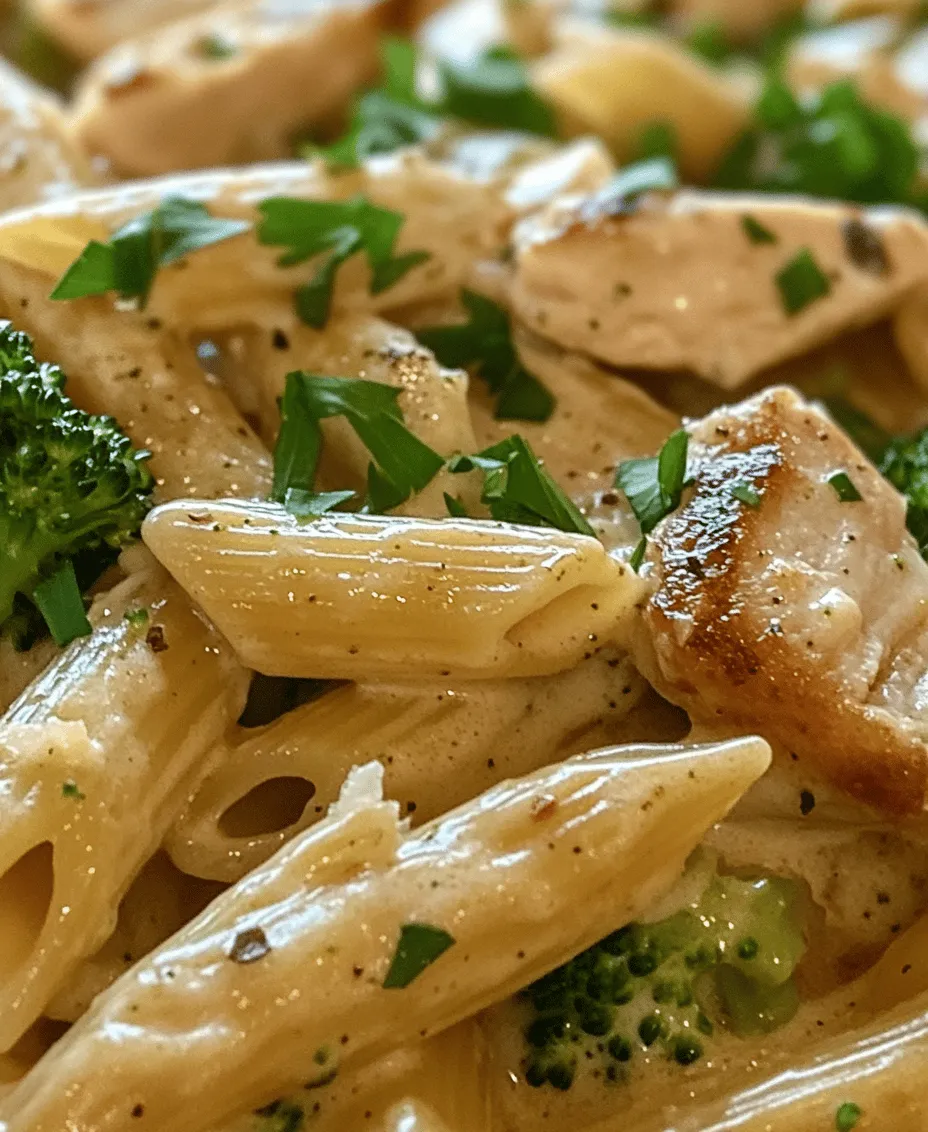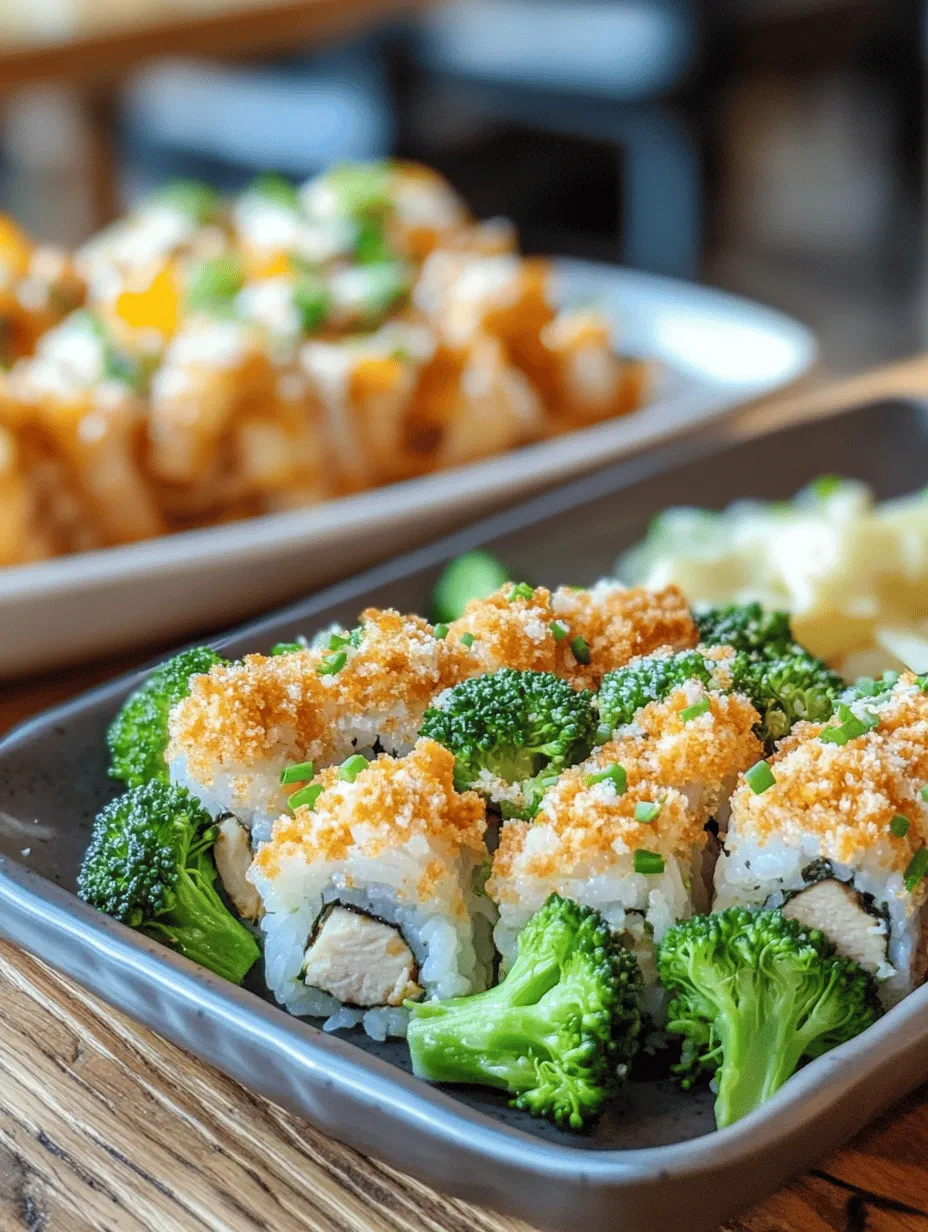In the world of comfort food, few dishes can rival the creamy goodness of pasta combined with tender chicken and vibrant broccoli. This Creamy Broccoli and Chicken Penne recipe offers a delightful blend of flavors and textures, making it perfect for family dinners or an impressive meal for guests. With its quick preparation time and the use of wholesome ingredients, this dish not only satisfies the palate but also nourishes the body. Let’s dive into the details of this easy yet delicious recipe.
Understanding the Ingredients: The Heart of the Dish
Every great dish starts with quality ingredients, and Creamy Broccoli and Chicken Penne is no exception. Each component plays a vital role in creating a harmonious balance of flavors and textures. Here’s a closer look at the key ingredients that will bring this dish to life:
Penne Pasta
Penne pasta is the foundation of this dish. Its unique tubular shape allows it to hold onto sauces beautifully, making each bite rich and flavorful. When cooked correctly, penne provides the perfect al dente texture, offering a satisfying chew that complements the creaminess of the sauce. Opt for whole grain or gluten-free penne if you’re looking for healthier alternatives without sacrificing taste.
Chicken Breast
Chicken breast serves as the lean protein source in this recipe, adding heartiness and substance. It’s important to choose fresh, high-quality chicken for the best flavor. Cooking the chicken just right ensures it remains juicy and tender, making it a delightful addition to the creamy sauce. Feel free to substitute with cooked rotisserie chicken or even grilled chicken for added flavor.
Broccoli
Broccoli not only adds a vibrant pop of color to the dish but also packs a nutritional punch. This nutrient-dense vegetable is rich in vitamins C and K, fiber, and antioxidants, making it a smart choice for any meal. When added to the creamy sauce, broccoli maintains a slight crunch, providing a lovely contrast to the tender pasta and chicken.
Heavy Cream
The secret to the rich, creamy sauce lies in the heavy cream. This ingredient transforms the dish into a luxurious experience, enveloping the pasta, chicken, and vegetables in a decadent coating. If you prefer a lighter version, you can substitute half-and-half or use a plant-based cream alternative.
Parmesan Cheese
Parmesan cheese enhances the flavor profile with its salty, nutty notes. Grated fresh Parmesan melts beautifully into the sauce, adding both creaminess and depth of flavor. For a unique twist, consider adding a touch of Pecorino Romano or even a sprinkle of goat cheese for extra character.
Garlic and Onion
Aromatics like garlic and onion are essential for building depth of flavor in this dish. Sautéing these ingredients releases their natural oils and sweetness, creating a fragrant base that enhances the overall taste. Fresh garlic cloves and yellow onions are recommended, but feel free to experiment with shallots or green onions for a different flavor profile.
Italian Seasoning
A blend of Italian herbs brings an authentic taste of Italy to this dish. This seasoning blend typically includes dried basil, oregano, thyme, and rosemary, which work together to elevate the flavors of the chicken and vegetables. For a fresher flavor, consider using fresh herbs if available.
Olive Oil
Used for sautéing, olive oil adds healthy fats and enhances the flavors of the dish. Choose extra virgin olive oil for its superior taste and health benefits. The oil also helps prevent sticking when cooking the pasta and chicken, ensuring a smooth cooking process.
Fresh Parsley
Fresh parsley serves as a garnish that brightens the dish visually and flavor-wise. Its subtle bitterness complements the creaminess of the sauce, while also adding a fresh note. Chopped parsley sprinkled on top just before serving makes the dish more appealing and adds a final touch of color.
Preparation Steps: Crafting the Perfect Creamy Penne
Now that you understand the essential ingredients of this Creamy Broccoli and Chicken Penne recipe, it’s time to prepare your kitchen for cooking. Follow these preparation steps to ensure a smooth cooking experience and a delicious final dish.
Setting the Stage: Cooking the Penne
Before you start with the sauce, you need to cook the penne pasta. This step is crucial to achieving the perfect texture and ensuring your dish is well-balanced.
Importance of Salting Water
When cooking pasta, salting the water is a critical step that many home cooks overlook. Adding salt to the boiling water enhances the flavor of the pasta itself. It’s recommended to use a generous amount of salt—about 1 tablespoon per gallon of water. The pasta absorbs some of this salt as it cooks, resulting in a more flavorful dish.
Achieving the Perfect Al Dente Texture
To achieve the ideal al dente texture, follow the package instructions for cooking time, but start checking the pasta a minute or two before the suggested time. Al dente pasta should be firm to the bite but not hard. Once cooked, reserve a cup of pasta water for later use in the sauce, then drain the pasta and set it aside.
Sautéing the Chicken: Creating Flavor Foundations
With the pasta cooking, it’s time to focus on the chicken. Sautéing the chicken properly is essential for building the dish’s flavor profile.
Choosing the Right Heat
Start by heating a generous drizzle of olive oil in a large skillet over medium-high heat. Once the oil is hot, add the diced chicken breast. Be sure not to overcrowd the pan, as this can lead to steaming rather than sautéing. Cook the chicken until it’s browned on the outside and cooked through, about 5-7 minutes. Use a meat thermometer to ensure the internal temperature reaches 165°F.
Seasoning Tips for Optimal Flavor
To maximize the flavor of the chicken, season it with salt, pepper, and a sprinkle of Italian seasoning while it cooks. This will allow the spices to infuse the chicken, creating a more flavorful base for the sauce. Once cooked, remove the chicken from the skillet and set it aside, leaving any drippings in the pan for sautéing the vegetables.
Sautéing the Vegetables: Building Complexity
With the chicken out of the skillet, it’s time to sauté the vegetables. This step will add complexity and depth to the dish.
The Role of Onions and Garlic
In the same skillet, add a bit more olive oil if needed and toss in the diced onions. Sauté them over medium heat until they become translucent, about 3-4 minutes. Next, add minced garlic and cook for an additional 30 seconds, stirring frequently to prevent burning. The combination of onions and garlic forms a fragrant base for the sauce.
Timing for Broccoli: Keeping It Crisp
To ensure the broccoli retains its vibrant color and crisp texture, add it to the skillet after the onions and garlic have softened. Sauté the broccoli for about 2-3 minutes, just until it turns bright green. You want it to be tender but still have a bite. Avoid overcooking, as this will result in mushy broccoli that lacks texture and nutrients.
With the chicken sautéed and the vegetables prepared, you are now well on your way to creating a delicious Creamy Broccoli and Chicken Penne. In the next part of the article, we will explore how to combine these elements and create the creamy sauce that brings this dish together. Stay tuned for the delicious conclusion!

Making the Cream Sauce: The Creamy Magic
Creating a luscious cream sauce is the heart of any creamy pasta dish, and our Creamy Broccoli and Chicken Penne is no exception. This sauce not only adds richness but also binds all the flavors together beautifully.
Techniques for a Smooth Sauce
To achieve a perfectly smooth cream sauce, start by melting butter in a large skillet over medium heat. Once the butter is melted, sprinkle in the flour to create a roux. This mixture should be whisked constantly for about 2-3 minutes until it turns a light golden color. This step is crucial as it eliminates the raw flour taste and contributes to a velvety texture.
Next, gradually pour in the chicken broth, whisking continuously to prevent lumps from forming. Once the broth is incorporated, slowly add heavy cream. The key here is to keep the heat at medium-low to allow the sauce to thicken without boiling, which can cause the cream to separate.
Balancing Cream and Cheese for the Best Texture
Once your cream sauce has thickened to your desired consistency, remove it from the heat and stir in the grated Parmesan cheese. This is where the magic happens! The cheese not only adds flavor but also enhances the creaminess of the sauce. For an extra depth of flavor, consider adding a pinch of nutmeg or black pepper. These spices can elevate the dish and bring out the best in the ingredients.
Combining Ingredients: The Final Touch
With your sauce ready, it’s time to combine all the elements for the final dish.
Tips for Ensuring Even Coating
Start by adding the cooked penne pasta to the skillet with the cream sauce. It’s best to toss the pasta in the sauce while it is still warm, ensuring that every noodle is thoroughly coated. To make this easier, use tongs or a large spoon to gently mix everything together. The goal is to have a consistent coating of sauce on each piece of pasta, so take your time with this step.
Adjusting Consistency with Pasta Water
If you find that the sauce is too thick, don’t fret! The starch from the pasta can help. Reserve about a cup of pasta water before draining the penne. Gradually add a small amount of this water to the sauce, stirring until you reach your desired consistency. This technique not only helps with the texture but also enhances the flavor profile, as the starch helps bind the sauce to the pasta.
Serving Suggestions: Elevating the Dining Experience
Once you’ve combined all the elements into a creamy, delicious dish, it’s time to serve!
Plating the Dish for Visual Appeal
Presentation plays a key role in enhancing the dining experience. Use a large serving bowl or individual plates to serve your Creamy Broccoli and Chicken Penne. A large bowl allows guests to help themselves, while individual plates offer a more formal presentation.
To plate, use a serving spoon to place a generous portion of the pasta in the center of the plate. Arrange the broccoli and chicken on top for an appealing visual effect. This not only highlights the ingredients but makes the dish look more appetizing.
Garnishing with Fresh Parsley: A Simple Yet Effective Touch
Garnishing is an essential step that adds a pop of color and freshness to your dish. Finely chop fresh parsley and sprinkle it over the top of the pasta just before serving. Not only does this add a beautiful contrast against the creamy sauce, but it also contributes a hint of freshness that balances the richness of the meal.
Complementary Side Dishes
To round out your dining experience, consider serving some complementary side dishes.
– Salads: A crisp green salad with a light vinaigrette is a perfect pairing. The acidity from the dressing can cut through the creaminess of the pasta, refreshing the palate.
– Breads: A warm, crusty baguette or garlic bread can enhance the meal, providing a satisfying crunch that contrasts the soft pasta.
Nutritional Insights: A Balanced Meal
Understanding the nutritional profile of your dish can help you enjoy it even more.
Breakdown of Key Ingredients and Their Benefits
– Broccoli: Packed with vitamins C and K, broccoli is a powerhouse of nutrients. It’s also high in fiber, which can aid digestion.
– Chicken: A lean protein source, chicken breast is low in fat and provides essential amino acids necessary for muscle growth and repair.
– Pasta: Whole grain or legume-based penne can offer additional fiber and nutrients, making this dish a balanced option.
A Look at Caloric Content and Portion Control
While this Creamy Broccoli and Chicken Penne is indulgent, it’s important to be mindful of portion sizes. A typical serving is about one cup, which generally contains around 400-500 calories, depending on the specific ingredients and amounts used. Balancing this meal with lighter side dishes can help maintain overall caloric intake while still enjoying a hearty meal.
Making It Your Own: Customization Ideas
One of the best aspects of cooking is the ability to customize recipes to suit your tastes and dietary needs.
Exploring Variations to Suit Different Tastes
– Adding Other Vegetables: Feel free to experiment with other vegetables. Carrots, spinach, or peas can add color and flavor, while also boosting the nutritional value of the dish.
– Protein Alternatives: If you’re looking for a vegetarian option, consider substituting chicken with tofu or shrimp. Both options will add a unique twist and can be flavored similarly to the chicken.
– Gluten-Free Alternatives for Pasta: For those following a gluten-free diet, opt for gluten-free pasta made from rice, quinoa, or lentils. These alternatives maintain a similar texture and taste, ensuring everyone at the table can enjoy the dish.
Conclusion: The Joy of Cooking and Sharing
Creamy Broccoli and Chicken Penne is more than just a meal; it’s an experience that brings families together. With its rich flavors and hearty ingredients, this dish exemplifies the joy of home-cooked comfort food. Whether you’re a seasoned cook or just starting in the kitchen, this recipe provides an easy pathway to creating something special. Enjoy the process of cooking, savor the results, and share this delightful dish with those you love. Cooking is not just about feeding the body; it’s about nourishing the soul, creating memories, and enjoying the simple pleasure of good food with great company.



